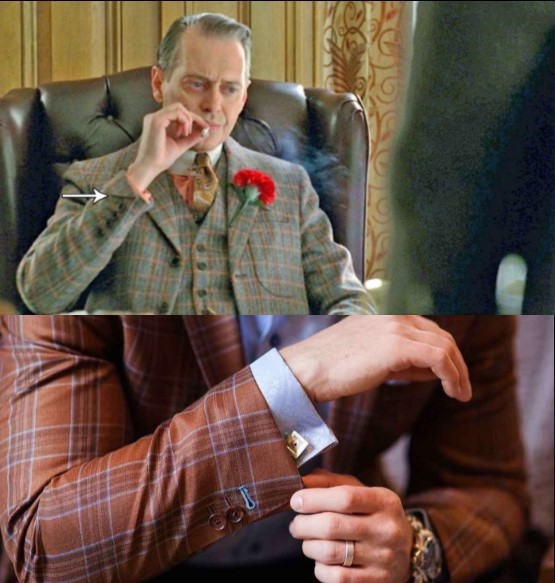
Surgeon Sleeves Functional button holes
Surgeon sleeves (Functional Button holes) now and then..
The History of Surgeon/Functional Button Holes On Custom Suits
There are several components found within custom tailored suits that aren’t seen on the off the rack ones. One of these is functional buttonholes, also referred to as surgeon cuffs from time to time. This is a feature of high quality suiting, and is reference to the sleeve buttons on a suit that are actually functional.
If you take a close look at the suits that are found right on the rack, the buttons are sewn directly onto the garment. They are for purposes of ornamentation only. However, buttons are generally for the purposes of fastening, or at least that’s what they have been used for throughout most of history. The material of the buttons have changed over the years, and even today, it is possible for them to be both decorative and functional.
What’s the History?
Why would a functional buttonhole be referred to as a surgeon’s cuff? They were aptly named because military surgeons had to unbutton and roll up their sleeves as a way of being able to treat wounds out on the battlefield. It’s important to know more about the buttons leading up to this point, though
Functional buttons appeared long before the suit. They were used for fastening or closing clothing as early as the 13th century, in Germany. A rise of snug fitting garments continued over the next century, and buttons became widespread. Even though the upper class still loved to show off all of the extra fabric, they used the buttons as a way of accentuating curves, particularly around the arms and the busts.
Throughout the mid to late 1800s, military pips wore jackets with regimental lace and a faux buttonhole. However, there was decoration on the sleeves because the tunic was always getting dirty in the field. One source claims that the reason for buttons on the sleeve began as an effort to keep young midshipmen and cabin boys clean and prevent them from wiping their noses on their sleeves, an effort put into place by Lord Nelson. This would allow everyone to roll up their sleeves so that they could keep their uniforms looking pristine whenever possible.
Savile Row, a prim and proper street in London, was an area heavily inhabited by surgeons prior to tailors moving in during the 19th century. The cuff buttons were similar to the pips of military rank. It allowed the sleeve to be rolled up easily. It was primarily used so that the surgeons would be to attend to their patients who were bleeding without having to remove their coats.
This was an important distinction that allowed surgeons to be set apart from the shirt sleeve wearing tradesmen found within the lower orders.
Doctors were part of the upper-class, and the surgeon’s cuffs became a way of identifying social rank. If surgeons had to remove their coats, it would mean making themselves look too much like the tradesmen, and this was found as unacceptable, even when treating the military on the battlefield.
Since doctors were part of the upper-class, it only makes sense now that tailored garments continued to follow a particular distinguishing mark of the upper-class.
Today, Savile Row is one of the better known areas of London (and the rest of the world) for tailoring. It is found in central London and has the reputation for bespoke tailoring for men. The functional button is used as it was 200 years ago because it has a reputation and a history behind it. It was used by the upper class and while social rank is no longer in place, it is used to distinguish between a person of fine taste and someone who finds no issue with picking up a suit
What Surgeon Cuffs Say
Today, surgeon’s cuffs or functional buttonholes on suits help to indicate refined taste in clothing. The bottom 1 to 2 buttons may be left unbuttoned in order to showcase more of the detail on the jacket. Italian clothiers will often insist on having at least one button open and this will show the style and the intricate design of what has been created.
With the customization of a tailored suit, it is also possible to create a casual look. The jacket cuff has the ability to be rolled up in order to show off the shirt cuff, a watch, cufflinks, or any kind of jewelry. The lining of the jacket can also be shown off, particularly if it is interesting or brightly colored.
Anyone who decides to sport a surgeon’s cuff should know about the history. It is created on a jacket, and the sleeve length is not to be altered once it has been created. A good tailor is going to know not to sew in the buttons and the buttonholes until the sleeve length has been fitted proportionately to the client. Otherwise, the proportion of the button cuffs will look improper, and people will make the assumption that it is off the rack as opposed to custom, which defeats the entire purpose.
The cuffs go back a long way, but when it comes to style and sophistication in a custom tailored suit, there’s one feature that cannot be ignored. Whether you refer to it as a functional buttonhole or a surgeon’s cuff, it’s the best way to show off that you know about class. Being able to identify its history ensures that one can take you seriously as well.
Recent Posts

